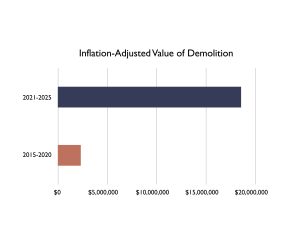
An analysis of building permit data from 2015 to present day shows a substantial increase in development value throughout Henry County, indicating a community that is attracting larger, more impactful projects with long-term significance.
From 2015 to 2020, the County issued 5,333 building permits representing just over $385 million in total construction value. In the years following, between 2021 and 2025, more than $687 million in total project value has been produced even though only 4,356 permits were issued.
When adjusted for inflation, the post-2020 total rises to over $742 million, reflecting a nearly 49 percent increase in real investment over the prior five-year period.
While the number of annual permits has remained relatively stable, averaging around 889 each year before 2021 and 971 each year since, each permit now represents significantly more private investment. Between 2015 and 2020, the average permit was valued at approximately $72,000. Since 2021, that figure has more than doubled to more than $158,000 per permit, even before adjusting for inflation.
This shift can be attributed to several factors including enhanced site readiness, consistent tax policy, and a long-term commitment to supporting economic development.
“These numbers reflect the wisdom of the Board’s forward-looking investments,” said Jim Adams, Chairman of the Henry County Board of Supervisors. “From preparing sites for major employers to keeping taxes low and maintaining a stable business climate, we’ve focused on creating an environment that allows growth to take root. We are now seeing the results.”
The highest number of permits in a single year occurred in 2018 with 1,044, while 2022 recorded the highest project value at more than $223 million. A contributing factor to the increased project value is more high-impact activities, such as the consecutive record-breaking economic development announcements at Commonwealth Crossing Business Centre and new commercial additions.
County Administrator Dale Wagoner noted that the data signals a growing level of confidence among investors looking to locate in Henry County.
“Companies are not just choosing to build here; they are choosing to build bigger than ever before,” Wagoner said. “That speaks to the value proposition we offer, from a skilled workforce to competitive infrastructure. Our ability to keep costs predictable, especially in essential services like water and sewer, remains one of our quiet strengths. It may not grab headlines, but it helps secure jobs and long-term investment.”
Henry County’s building permit activity continues to demonstrate strong momentum across multiple sectors, signaling sustained economic vitality and community growth. Industrial and manufacturing investments remain a major driver, with significant expansions reinforcing the county’s position as a hub for long-term business commitments.
While not traditionally viewed as a measure of growth, permit data on demolition activity has also spiked in recent years. For the period of 2015-2020, the number of demolition permits was 106 compared to 136 permits from 2021 until present day. However, the dollar value of demolition during those periods is drastically different. After accounting for inflation, post-pandemic demolition project values reached slightly more than $18 million compared to only $2.3 million for the pre-pandemic period. These figures are important when considering growth, as they pertain to activities that both remove blight and clear the way for future investments in residential or commercial development.
The county is also experiencing steady residential and commercial growth. New housing developments and renovations, such as the School Drive Apartments, are responding to rising demand for quality living options, highlighting Henry County’s appeal as a desirable place to live and raise families. Commercial permits are also on the rise, reflecting the expansion of retail and service businesses that support both local residents and industry workers.
This balanced growth across residential, commercial, and industrial sectors reflects the success of the Board’s wise investments in site readiness, infrastructure, and maintaining competitive tax rates. It signals investor confidence in the county’s future, underpinned by a skilled workforce and predictable operating costs, including some of the lowest water and sewer rates in the region.


